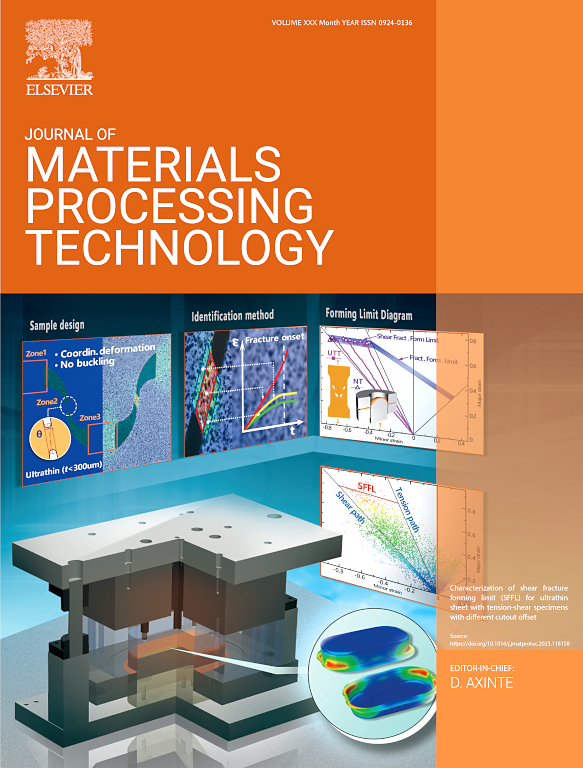Regulating electric field with electrode rotation to enhance surface quality in sinking electrochemical milling of groove
IF 6.7
2区 材料科学
Q1 ENGINEERING, INDUSTRIAL
Journal of Materials Processing Technology
Pub Date : 2025-05-13
DOI:10.1016/j.jmatprotec.2025.118898
引用次数: 0
Abstract
This research introduces a method of regulating electric field with electrode rotation to enhance surface quality in sinking electrochemical milling of groove. A tube electrode with partial insulation on sidewall is employed, when the exposed part of tube electrode’s sidewall faces the machining area, the power supply is activated for material dissolution and then switched off if the exposed part rotates to already machined area, reducing stray corrosion. Based on the correlation between electrode rotation angle and power supply state within one full rotation, four regulation modes were developed. In mode 1, power supply keeps switch-on during a full rotation of electrode, and the on-time ratio is 100 % (360°/360°). The ratio is 50 % (180°/360°) in mode 2, as the power supply is switched on in half of rotation. It’s 40 % (144°/360°) in mode 3, and 30 % (108°/360°) in mode 4. Simulations revealed that the already machined area suffered from pulse current density with peak gradually decreased in mode 1, exposing it to low current density. This issue was effectively eliminated in other modes. Experiments showed a significant reduction of corrosion pits on already machined surface from mode 1 to mode 4, with surface roughness decreased from 2.78 μm to 1 μm. Oxygen content in the already machined area also decreased. Further analysis indicated that uneven breakdown of oxide films at low current density led to poor surface quality of already machined area, and mode 4 effectively prevented this, enhancing surface quality. This research advances sinking electrochemical milling for high-quality manufacturing.
用电极旋转调节电场,提高槽槽电解铣削的表面质量
介绍了一种利用电极旋转调节电场以提高槽槽电解铣削表面质量的方法。采用侧壁部分绝缘的管电极,当管电极的侧壁外露部分朝向加工区域时,激活电源使材料溶解,如果外露部分旋转到已加工区域则关闭电源,减少杂散腐蚀。基于一圈内电极旋转角度与电源状态的相关性,提出了四种调节模式。在模式1中,在电极全旋转过程中电源保持接通,导通率为100 %(360°/360°)。该比率是50 %(180°/360°)在模式2,因为电源是在旋转的一半打开。模式3为40 %(144°/360°),模式4为30 %(108°/360°)。模拟结果表明,已经加工的区域受到脉冲电流密度的影响,在模式1下峰值逐渐降低,使其暴露在低电流密度下。这个问题在其他模式中被有效地消除了。实验表明,从模式1到模式4,已加工表面的腐蚀坑显著减少,表面粗糙度从2.78 μm降低到1 μm。已加工区域的氧含量也有所下降。进一步分析表明,低电流密度下氧化膜击穿不均匀导致已加工区域的表面质量较差,模式4有效地防止了这种情况,提高了表面质量。该研究为高质量制造提供了新的思路。
本文章由计算机程序翻译,如有差异,请以英文原文为准。
求助全文
约1分钟内获得全文
求助全文
来源期刊

Journal of Materials Processing Technology
工程技术-材料科学:综合
CiteScore
12.60
自引率
4.80%
发文量
403
审稿时长
29 days
期刊介绍:
The Journal of Materials Processing Technology covers the processing techniques used in manufacturing components from metals and other materials. The journal aims to publish full research papers of original, significant and rigorous work and so to contribute to increased production efficiency and improved component performance.
Areas of interest to the journal include:
• Casting, forming and machining
• Additive processing and joining technologies
• The evolution of material properties under the specific conditions met in manufacturing processes
• Surface engineering when it relates specifically to a manufacturing process
• Design and behavior of equipment and tools.
 求助内容:
求助内容: 应助结果提醒方式:
应助结果提醒方式:


